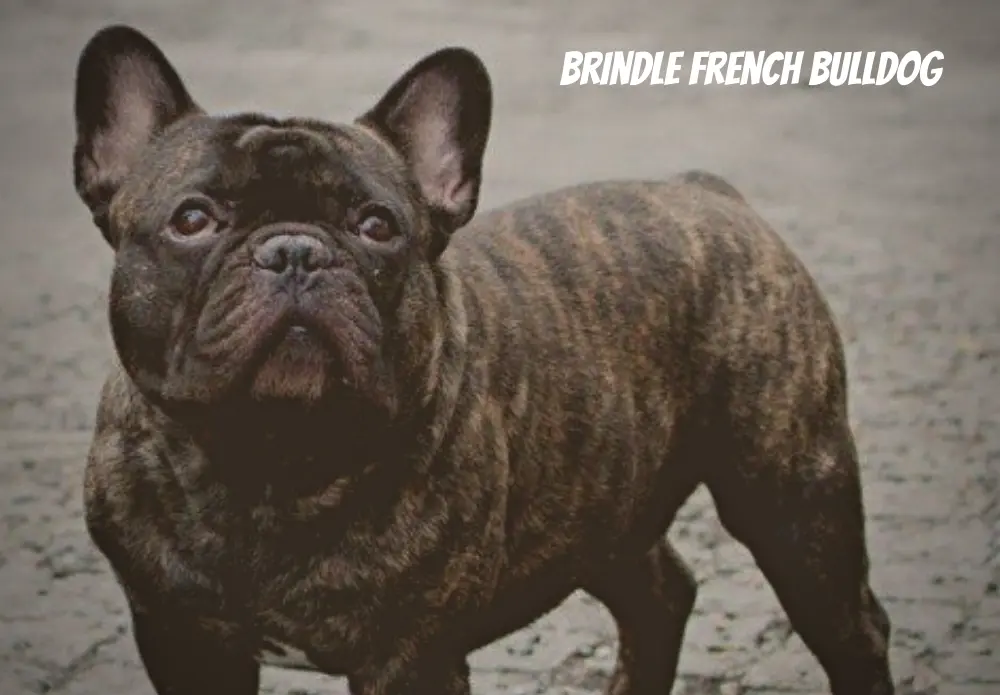French Bulldogs are loveable not just cause of their personalities but also because of their colors; one of these colors is Brindle. Brindle Frenchies have stripe markings on their body, making them appear unusual but unique.
Brindle Frenchies are filled with love, which they would love to share if you get one. Let’s talk in detail about the Brindle French Bulldogs:
What is a Brindle French Bulldog?
Brindle French Bulldogs are French Bulldogs that have a tiger-striped pattern on their coat. The pattern is irregular streaks of color that are darker than their base color.
Light and dark stripes create a distinctive, enchanting coat different from your typical French Bulldog. The Brindle Frenchie might appear light or dark depending on the pattern’s colors.
Due to the Brindle being a pattern rather than a Color, it is possible to have the Brindle effect in various colors. Also, with it being a dominant gene, it is not rare to see a Frenchie with Brindling, although some colors mask this.
While many genes contribute to the brindle pattern, the K-Locus gene is mainly responsible for dominant black, fawn, and brindle colors. Three types of K-Locus genes create the lovely brindle French Bulldog.
A Frenchie with a brindle coat would need a K gene from both parents. Other genes play a role in the brindle coat pattern; this means each brindle French Bulldog is unique. Some coats show the brindle pattern, while others have it in certain areas.
Characteristics of A Brindle French Bulldog
Other than the coat pattern, all the characteristics of the Brindle Frenchie are the same. Brindle French Bulldog appears to be an active muscular dog with heavy bones, a smooth coat, and a medium or small size that is compactly built. The cute puppy has an expression of alertness and curiosity and is always interested.
The back of Brindle Frenchie is bent with a slight fall close after the shoulders, short and strong, broad at the shoulders and contracting at the loins. The body is short and well-rounded. The chest is deep, comprehensive, and complete, well ribbed with the belly tucked up.
The tail is often straight or sometimes screwed (but not curly), short, hung low, deep root and fine tip, carried low in repose. Any modification is to the Frenchie other than removing dewclaws is considered mutilation and unnatural.
1. Size and Weight
Since the French Bulldog is a small breed, its size is also small. The male Brindle French Bulldogs usually grow from 10 inches (27 cm) to 13.7 inches (35 cm), whereas the females grow from 9 inches (24 cm) to 12 inches (32 cm).
The Frenchie males weigh 20 to 30 pounds, and the females weigh 17 to 28. So, Frenchies are not giants but tiny and cute, just like a rabbit.
2. Coat and Color
The coat of the Brindle Frenchies is short and smooth that does not shed much. It is easy to maintain and comes in a wide Brindle variety.
The different color combinations of Brindle are:
Black Brindle French Bulldog
The typical Brindle Color people think of is a mix of Brown/Black striping. This combination is often seen on a French Bulldog and is the most common. There are, however, several other colors that can have a Brindle effect. The AKC recognizes black Brindle, so that you can register it officially.
Blue Brindle French Bulldog
To have a Blue Brindle, a particular set of recessive genes needs to be present. This requires the dilution gene, which lightens the base coat color. This is often called the Blue gene in the D Locus. Due to this being a recessive gene, it is much rarer and requires both parents to pass on the coloring.
The Brindling effect on a Bluecoat will lead to lighter and darker shades of Blue throughout. Breeders often try to avoid the Brindle pattern, but it is highly popular with pet owners due to the beautiful patterns it can produce.
Blue Brindle is one of the most expensive combinations and the rarest. It is, however, not recognized by the AKC.
Reverse Brindle French Bulldog
Reverse Brindle relates to a phenomenon where the Brindle effect appears to be in reverse due to larger areas of lighter color. While this is down to different genetics, it is no different from a regular Brindle.
Brindle & White French Bulldog
As with any other French Bulldog, it is common to have white markings, usually on its underside. While these parts of the Frenchie will not be Brindle, it does not stop the rest of the coat from showing the Brindle effect. This can result in the darker areas of the coat being Brindle with White areas.
Brindle and White Frenchies are standard color patterns recognized by the AKC.
Brindle Pied French Bulldog
Like the Brindle and White French Bulldog, the White areas will not be brindled, but the spots will be. A Brindlled Pied can create a unique look in that there are patterns of spots on a primarily white dog.
Brindle Pied is not on the American Kennel Club (AKC) list of recognized French Bulldogs.
Lilac Brindle French Bulldog & Isabella Brindle French Bulldog
While very similar in appearance, Lilac and Isabella are two different types of chocolate coloring that the Blue gene has diluted. Similar to other shades, these can also be affected by the brindle pattern.
As with any diluted color, the Brindle pattern does not appear as clearly as Brown/Black. You will, however, be able to note the Brindle of the Lilac coloring.
Chocolate Brindle French Bulldog
A Chocolate with Brindle stripes is called a Chocolate Brindle, which is very uncommon. A chocolate brindle is a mix of milky and brown colors. Chocolate Brindle is not AKC recognized.
3. Head and Facial Features
Brindle French Bulldogs have large, broad heads that are almost square. French Bulldogs have big round eyes that sit near the muzzle and separate from the ears. The eyes are neither too deep into the skull nor bulging out.
The ears are large bat-like, wide at the bottom and pointy but round at the end. These ears are Frenchies’ iconic feature, so any modifications will disqualify them.
A broad upper jaw hangs over the lower jaw on the sides, almost entirely covering it. Extra skin over the neck wrinkles up, giving the brindle Frenchie a cute and adorable look.
4. Personality and Temperament
French Bulldogs are very social and active dogs. They love to make new friends and get lots of praise from its owner. Frenchies are known for their calm demeanor and attractive aura.
French Bulldogs are amazing dogs who quickly get along with people, children, and other pets. They’re also considered an intelligent dog breed and lovable companions out there.
What is the Cost of A Brindle French Bulldog?
Brindle is a standard pattern of the French Bulldog and has some of the lowest prices among the Frenchies. The base price for a Brindle French Bulldog is $3000, but it can go up depending on the color of the puppy.
The non-standard colors mixed with Brindle cost more, where some can go for up to $7000.
The Lifespan of A Brindle French Bulldog
The average lifespan of the Brindle French Bulldog is 10 to 12 years. It can be affected by a few factors, such as diet, health, environment, training, and exercise. The life expectancy of the Brindle dog is most affected by health and diet. Here are some of the most common health issues a Brindle French Bulldog can have:
Allergies
Brindle Frenchies are prone to seasonal allergies but can also be triggered by allergens. Pay extra attention to their food content to avoid any dangerous mishaps.
Wandering Eye
Wandering eye is a case of Microphthalmia with multiple defects. Eye degeneration aids the condition, and the lens becomes liquefied as it progresses.
Corneal Ulcers
Because the eyes stand more predominately on the Frenchies’ faces, they are at risk of eye issues. Brindle Frenchies can also be born with small pieces of tissue sticking out of their eye. It is best to go to the vet if you detect this or any redness/lumps around the eye.
Brachycephalic Airway Syndrome (BAS)
Brachycephalic Airway Syndrome usually results in snoring and noisy breathing. It can, however, lead to retching, regurgitation, and vomiting, undoubtedly lowering their heat tolerance.
Back and Spine Issues
Unfortunately, it is more common in French Bulldogs to have problems around their back and necks. Spine issues often result in back pain and occasionally slipped discs. Often these issues will exhibit later in life, and it is best to consult a vet.
Ear Infections
Due to the shape of the French Bulldog’s ears, they can have issues keeping their ears clean. These areas often become breeding grounds for bacteria.
Skin Fold Dermatitis
While we love their wrinkles and skinfolds, it can lead to issues within these folds. Check these areas for redness and sores; your Frenchie will usually attempt to scratch any irritated areas.
The lifespan of the Brindle French Bulldog is also affected by its diet, so here is what you should feed your Exotic French Bulldog.
Diet & Food for Brindle French Bulldog
Meat
Meat is an excellent source of protein for dogs, so be sure to feed lots of meat products. Many premium food brands contain three types of meats: beef, lamb, fish, chicken, and duck.
Check all the ingredients and consult the vet before feeding the dog. You can also check the labels on the packaging to ensure a 30% protein intake.
Vegetables and Herbs
If you are buying a premium food brand, then you may not have to worry much about the vegetable intake of your Brindle French Bulldog. Many food brands contain vegetables such as peas, carrots, and potatoes.
You can add some to the food bowl if your dog food does not already contain vegetables and herbs. Your dog can eat a small amount of greens to help with digestion.
Fats
Fats are also essential to the survival and growth of a dog. Protein is digested to make muscles and cells, but the fat is converted into energy. Your dog cannot survive on an all-protein diet and needs fats.
Omega-3 fatty acids maintain your Frenchie skin and coat healthily and lustrously. Omega-3 products like fish oil and coconut oil are some examples.
Your French bulldog puppies’ veterinarian could advise feeding them a diet rich in the crucial fatty acid docosahexaenoic acid (DHA).
Vitamins & Minerals
Ask the vet for some essential minerals and vitamins to avoid health issues. The diet must include vitamins A, B, C, and D and minerals such as calcium, iron, and potassium.
You can add these to the food or get food containing them.
Pros and Cons of Having a Brindle French Bulldog
Like any other dog breed, Brindle French Bulldog has pros and cons. Here is a list of the pros and cons of a Brindle Frenchie.
Pros
- A brindle French Bulldog can fit right in whether you live in an apartment or a house. They only take up a little space, meaning they’re pretty simple to travel with!
- Brindle Frenchies don’t shed daily, and when they do, it’s minimal. In addition, Frenchie’s hair is short and easy to clean. Regular hair brushing can minimize their shedding.
- Frenchies typically have little stamina to burn. Short walks and a little playtime are about all the exercises they need. French Bulldogs are couch potatoes who love to cuddle!
- French Bulldogs are known for their loyalty. Bringing this little fur ball to your home will assure you a loving, lifelong companion.
- French Bulldogs are adorable, but the brindle coat is so captivating that your brindle Frenchie will undoubtedly be a head-turner.
Cons
- Brindle French Bulldogs are a popular dog breed whose price label reflects this. Brindle Frenchies can typically cost anywhere from $3,000 – $7,000.
- All French Bulldogs are susceptible to health issues. Common health conditions in Frenchies are Skinfold Dermatitis Obstructive Syndrome (BOS), Brachycephalic, and Cherry Eye. Choosing a reputable breeder can minimize the chances of medical issues in your new pup.
- Since many French Bulldogs suffer from BOS, they have trouble breathing. Hot climates can worsen this since their thin coat also makes them more prone to sunburn. Due to their thin coat, Frenchies also can’t stay warm in freezing weather. So all of this means that mild temperatures are best for a French Bulldog.
While the cons are worth viewing, the pros outweigh the negatives of having a brindle French Bulldog join your family.
Tips for Taking Care of Your Brindle French Bulldog
Brindle Frenchies are highly sought-after because of how low maintenance they are. They are easy to care for if you follow a few easy steps.
Regular Vet Visits
Since French Bulldogs are prone to health issues, visiting the vet every six months lets you stay on top of your puppy’s health. I know this can get expensive, but having pet insurance can ease some financial stress from regular vet visits.
Grooming
The most distinguishing characteristic of a brindle French Bulldog is its coat, which you should maintain in good condition. This can be accomplished by bathing roughly four times a year and brushing your hair frequently.
Provide a High-Quality Diet
A Brindle Frenchies Important factors like their gorgeous coat and general health are impacted by Frenchies’ food. Water, minerals, vitamins, healthy fats from meat, oils, grains made from fruit, vegetables, rice, oats, and barley, and decent carbohydrates are all ingredients to incorporate.
Avoid gluten, corn syrup, white flour, artificial food coloring, preservatives (BHT and BHA), and preservatives. Here is a comprehensive guide to feeding a French Bulldog.
Be Mindful Outside
Monitoring French Bulldogs near water is essential since they can’t swim well due to their large chests. Frenchies shouldn’t be in the sun for too long as they can easily get sunburned due to their thin coats.
Crate Training
French Bulldogs crave attention and may suffer separation anxiety when their owner is away. Crate training is one of the best solutions for such puppies, as it provides a sense of security. Crate training is also helpful for housebreaking puppies and senior dogs and for travel convenience.
FAQs – Frequently Asked Questions
Is a Brindle French Bulldog Rare?
Brindle is a typical pattern in French Bulldogs and is one of the recognized color combinations by the AKC. Some patterns, such as blue Brindle, chocolate brindle, Isabella Brindle, and Lilac Brindle, are rare due to the rarity of the recessive genes.
How Much is a Brindle French Bulldog Worth?
A regular Brindle French Bulldog is worth $3000, making it the least expensive. It can cost more, but you will still find it cheaper than other breed colors.
What Does Brindle Mean in French Bulldog?
Brindle in French Bulldog means stripes of color over a solid base coat. These stripes can be in the tiger pattern or a completely random style. The dominant K-allele causes the brindle pattern, and it is widespread.
Are Brindle French Bulldogs Purebred?
Brindle French Bulldogs are purebred. It is one of the oldest colors in French Bulldogs. To be considered a purebred, the puppy must have purebred parents, and usually, Brindles have that.
But in some cases, breeders mix up other impure dogs to create new patterns, which can lead to health issues. Getting a DNA check of the Frenchie puppy and its parent dogs is best to know for sure if your dog is purebred or not.
Conclusion
For those who like to get a pet dog for its personality and not its color, the Brindle French Bulldog is the best choice. Many people dislike these dogs because of their coats without knowing that they are purebred.
The personality of the Brindle French is enough to overshadow its looks, although there is no flaw in its look. Keep an open mind, and get a Brindle French Bulldog.






